After a long hiatus, it’s time for a little film analysis from the great white north. I apologize for being away, I’ve been locked in a secret hideaway, in the farthest reaches of the Canadian wilderness, simultaneously working on a project to train grizzly bears, moose and muskrats to play football and working with NBC and Notre Dame to develop the peacock streaming service. At this point, both those projects seem to be going as well as the 2021 Notre Dame football season….
No doubt, injuries, new schemes, new players have all combined to create a perplexing start to the season. Coaches can’t control injuries and they can’t make inexperienced players instantly experienced. However, they do have they ability to align their players in ways that increase the likelihood of success. Unfortunately, the coaching staff (on both sides of the ball) has struggled at times to get players lined up in ways that make it easier for them to execute their assignment.
Let’s take a look at the film and I’ll show you what I mean.
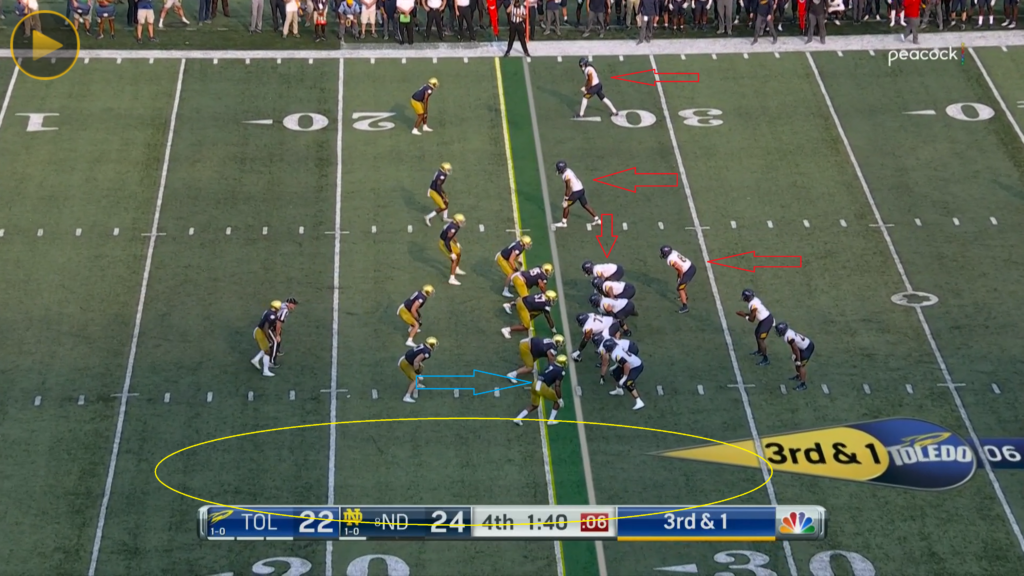
3rd and 1 late in the 4th quarter with Notre Dame clinging to a two-point lead. The Irish, really could use a stop here. Pre-snap, Toledo shifted two tight ends to the top of the screen giving them 4 receivers to that side of the formation (red arrows).
In response, Notre Dame shifted their personnel toward the four-receiver side. This leaves Notre Dame with only defensive end Isaiah Foskey (blue arrow) outside the tackle. If the offense breaks contain, there is a lot of open space to work with (yellow circle).
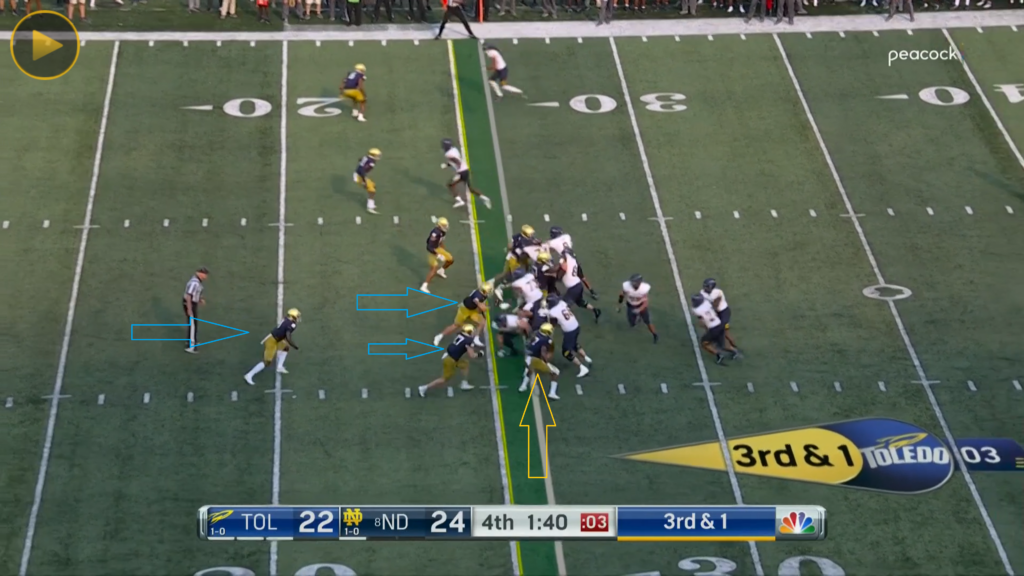
A fraction of a second after the snap. Both linebackers and the safety at the bottom of the screen (blue arrows) react aggressively to stop the run. Unfortunately, they look as though they have been coached by a World War I general, who has drilled into their head they must charge forward into no man’s land without any thought. Don’t worry about where the play is going. Don’t worry about leverage, contain, spacing. Just attack straight ahead! To make matters worse, the lone player lined up outside of the tackle, Isaiah Foskey (gold arrow), has abandoned his post on the edge of the defense and is joining the rest of the crew in no man’s land.
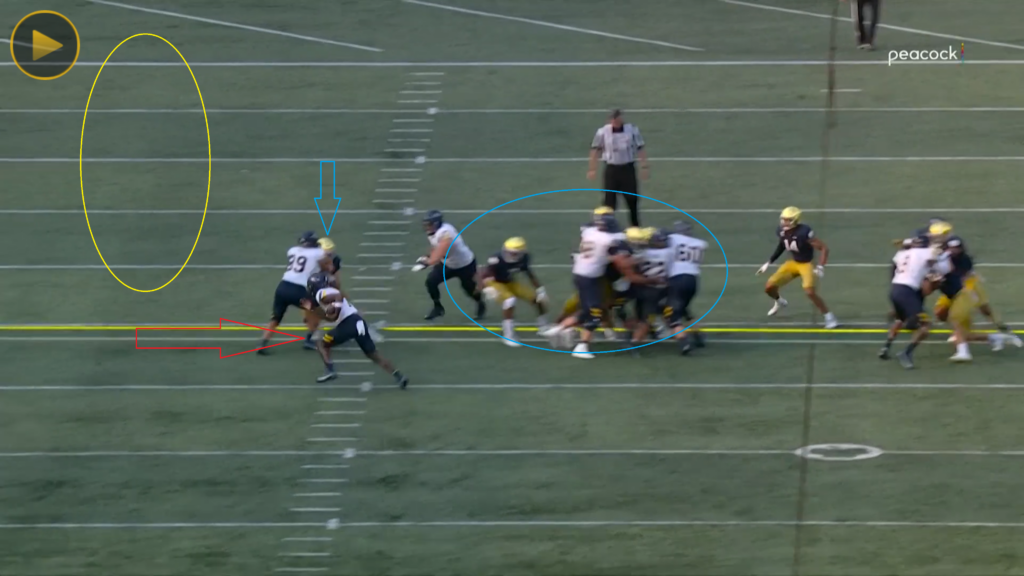
It’s hardly surprising that having 4 defenders bunched so tightly together (blue circle) is not a recipe for success. With only one defender trying to keep contain (blue arrow), the defense is flanked and the ball carrier (red arrow) is about to sprint into the open field we identified pre-snap (yellow circle) for a touchdown.
Summary – Defense
Although this is only one play, it illustrates problems the have plagued the Irish in the first two games of the year. Pre-snap, we have a tendency to adjust too much to the strong side of formations. This makes us vulnerable away from the strong side. Post-snap, our linebackers and safeties have a tendency to run forward blindly without fully understanding where the ball is going. This exacerbates the pre-snap vulnerability and results in players bunched together out of position. Which leaves large gaps in the defense. Which leads to big plays for the offense.
Challenges for the Offense
Unfortunately, the offense hasn’t been immune to spacing issues.
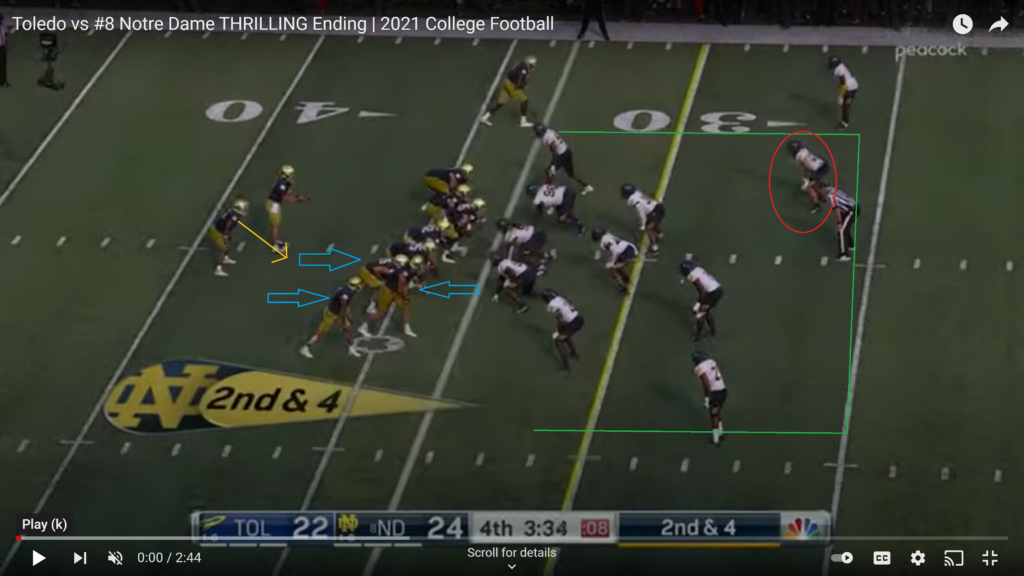
2nd and 4 in the 4th quarter. A first down here would be very helpful. Notre Dame comes out with a bunch formation at the bottom of the screen with two tight ends and a receiver (blue arrows) and will run behind the bunch (gold arrow).
Notre Dame’s alignment on this play allows Toledo to place 10 defenders in a relatively small area (green lines). This means all 10 are a threat to make a tackle if the ball is run anywhere inside of those green lines. To illustrate this point, let’s watch the backside safety (red circle), to see if he can be a factor in a run play on the other side of the formation.
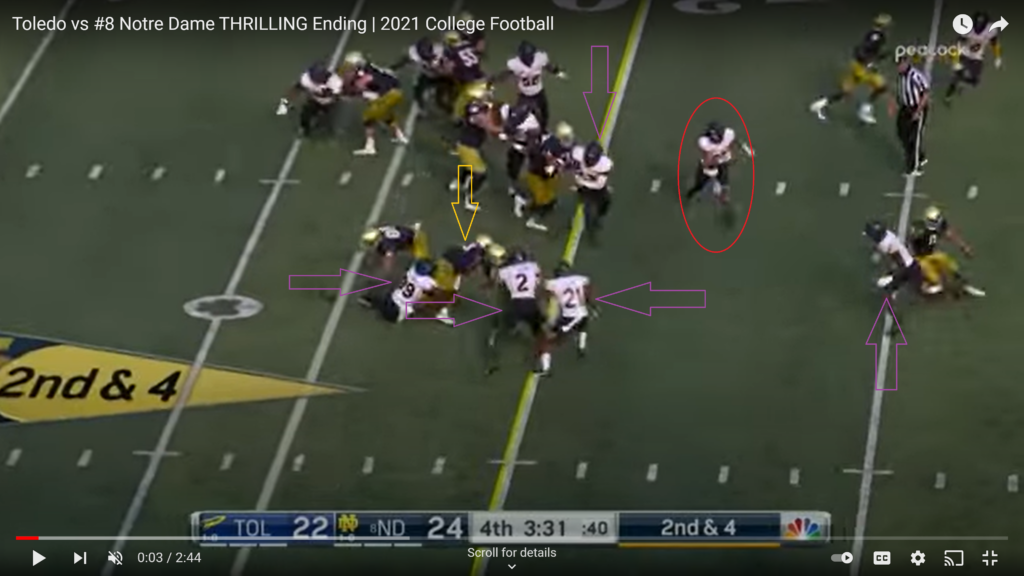
Kyren Williams is in the grasp of a defender just short of the first down (gold arrow). Although he’s fighting for every inch, the reality is Notre Dame is outmanned at the point of attack. Toledo has 5 defenders near the ball carrier (purple arrows). As for the backside safety we were watching, he’s also in good position to make a play (red circle).
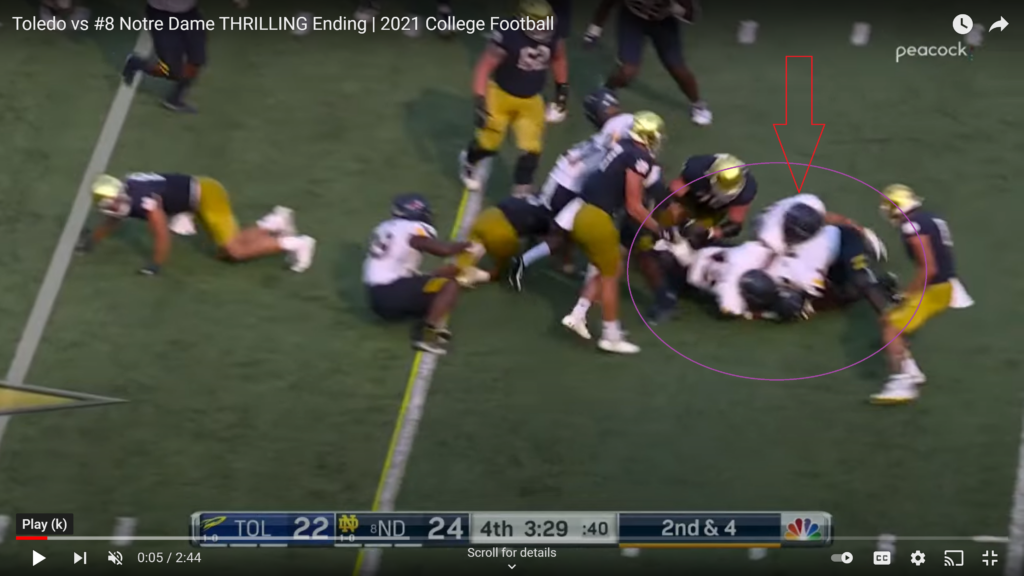
Unfortunately, Williams fumbled on the play. Given the number of defenders Toledo had near the ball, it was a pretty easy recovery for the defense with three players pouncing on the ball (purple circle). As you can see, the backside safety we were watching (red arrow), had no problem coming across the formation and getting into the play.
Tight formations have been a common part of the Notre Dame offense early in the 2021 season. While teams can be successful running out of this alignment, it appears at this point in the season, the Irish aren’t well suited for this type of play. This formation leaves very little room for talented players like Kyren Williams and Chris Tyree to break free. Traditionally, this type of formation is used to get the defense to bunch up, so the offense can attack outside. As opposed to forcing the defense to bunch up and then running directly into all the defenders.
Spreading Out
Fortunately, with a bit of tweaking, a formation like this can create space for skill players.
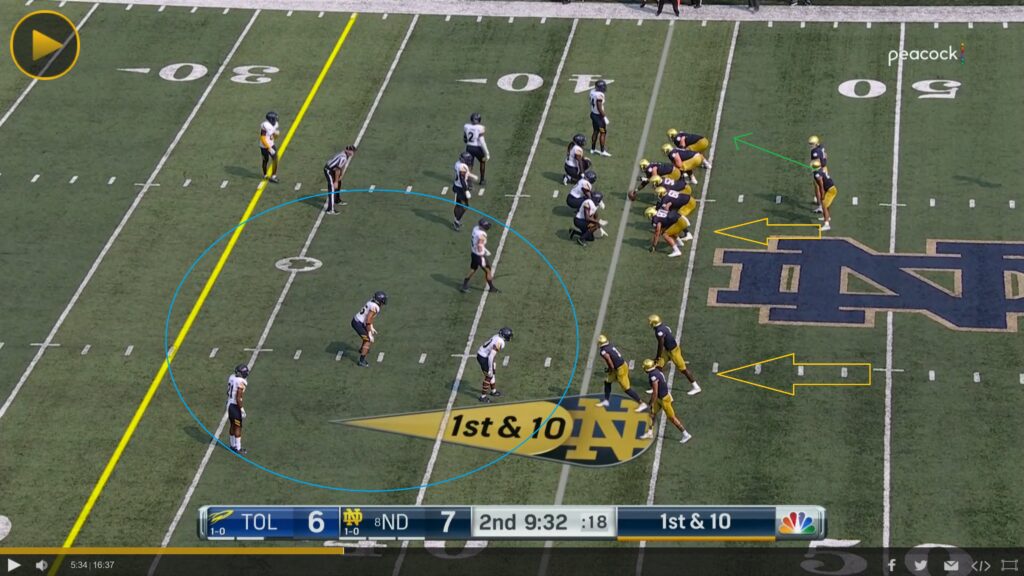
Here is a bunch formation with three receivers and an attached tight end (gold arrows). The difference here is the bunch is separated from the rest of the formation. This alignment requires the defense to slide 4 players out to the perimeter (blue circle). Notre Dame is going to run the ball away from the bunch (green arrow).
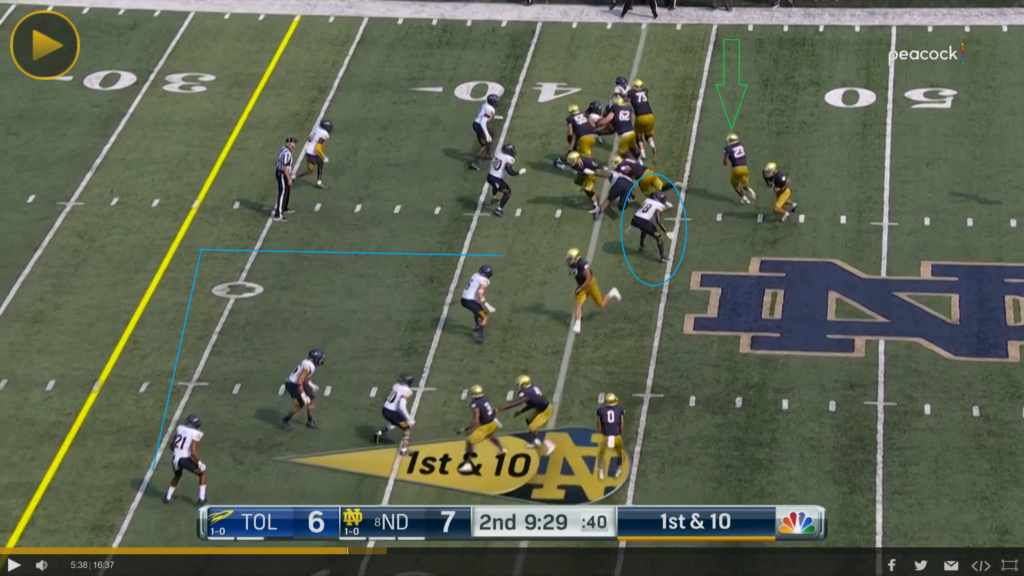
A fraction of a second after the snap. Williams is running away from the bunch side of the formation (green arrow). In this instance, the formation and play design removed 5 defenders from the equation. The 4 players out on the perimeter covering the bunch and the tight end (blue lines) and one defender occupied by the quarterback (blue circle).
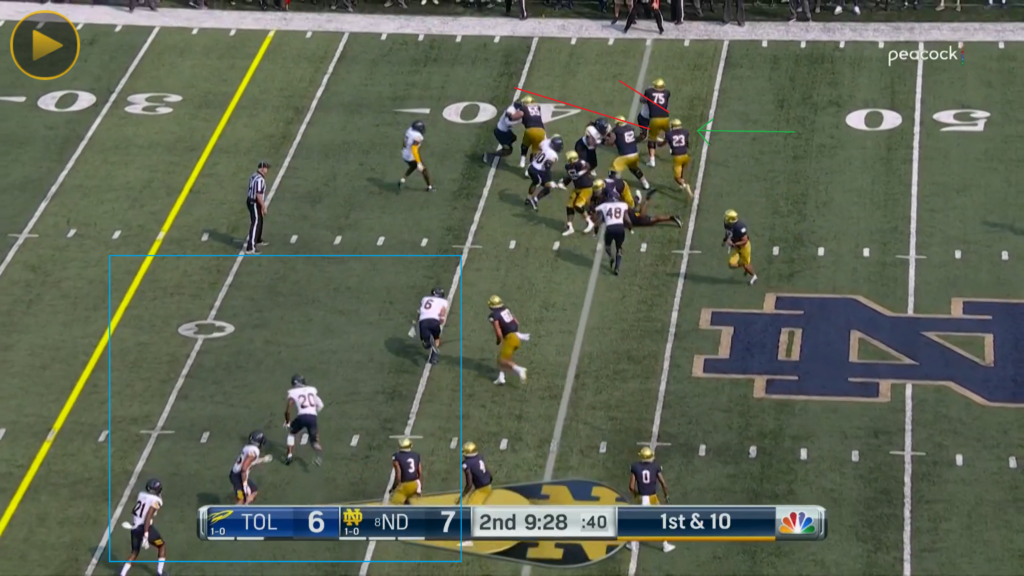
Williams (green arrow) sees a crease in the defense (red lines) due to a combination of good scheme and strong blocking from the entire offensive line. This play is a great example of what happens if you give skill players a bit of space. Williams didn’t have to dodge 10 defenders (blue box) on the play and ended up turning a little space into a long touch down.
Final Thoughts
On the defensive side of the ball, Notre Dame needs to do a better job of understanding alignment, leverage and taking the correct angles to get to the ball. We have a tendency to over adjust to formations and run blindly towards the line of scrimmage hoping to make a play. Sometimes this results in big plays for the defense. Sometimes it results in big plays for the offense. Moving forward, the key will be to maintain this aggression, but apply it with greater understanding and purpose.
Offensively, we need to create more space for our playmakers, especially on the perimeter of the offense. We cannot continue to ask players like Kyren Williams and Chris Tyree to run behind formations that put so many potential tacklers near the point of attack.
While alignment and spacing won’t fix all the challenges Notre Dame is facing this year, if we continue to struggle with these foundational elements of football, it will be nearly impossible to address other issues. If we can fix these problems, our playmakers will have more opportunities to be successful and that’s a good thing.
In other words, when the Notre Dame players bunch together like a gaggle of flying squirrels trying to stay warm, bad things happen. When they spread their wings and fly, good things happen. I say let those squirrels spread their wings and fly.

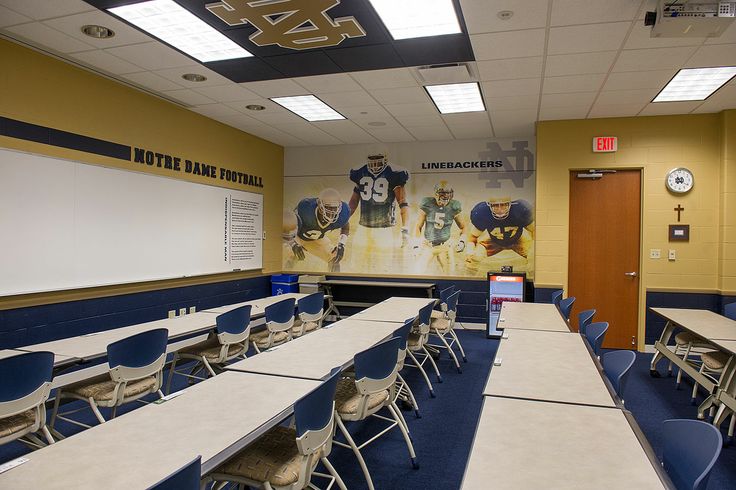



Thanks for the return. Always great stuff. One thing about the first play you mentioned: I don’t think we win the game if they didn’t defend it so poorly…or at least don’t get a sack on the play. Toledo is easily within field goal range. Any advancement allows them to knock out the clock. Is it possible that the players are being told to be extra aggressive because the coaching staff only wants a sack with significant loss of yards or for Toledo to score and get us the ball back ASAP? I don’t think Kelly would admit to wanting Toledo to score, but Weis has admitted as much when he was coaching in a similar position.
And now that I’m justifying my position using Weis as an example, I just threw up in my mouth a little.
Thanks Idocd! That’s a great point
No doubt, Toledo scoring there ended up helping. It’s possible that ND just let them score, but I haven’t seen that strategy much from BK. Certainly if you are going to let them score this alignment and post snap reaction would be a good way to do it.
A few things lead me to believe this wasn’t purposeful. The over adjustment and tendency to attack straight ahead blindly are trends I’ve seen repeatedly from the defense. This isn’t isolated. Toledo shifted pre snap into this formation. For this reaction to be pre planned the ND staff would have needed to know Toledo was going to shift and the. Communicate to their players to over shift and be over aggressive. As well, this was a read option by the QB, so ND would have to know to give the QB a keep to the outside read as well.
This year anything is possible, so maybe they did try to give up the TD and if they did this play would actually be an example of remarkable coordination!!
Great stuff and sorely missed, Lars. Welcome back.
I agree with you, this wasn’t a “let em score” alignment, it was a coaching faux pas. Freeman should have called a time out, assuming we had one, or somehow changed the defensive call. I’m not impressed with his scheme or coaching yet, although I hope that comes.
For reference, by the way, OSU got gashed for 2-3 TDs and other long runs by being in terrible defensive formations, and not changing/adjusting ever to the same Oregon offensive formation. They were terrible all day against the run.
Thanks kiwifan!!
It’s amazing how challenging getting lined up on defense can be.and it creates a lot of issues when they don’t line up correctly
Thing that killed me on the Toledo touchdown was that they put in their running quarterback. And then didn’t keep the edge on their running quarterback.
Yes! We probably should have seen that coming!
Great article and love the humor sprinkled in there!
Would lining up in a bunch formation and then running straight into it work if we had a grizzly or moose in the backfield? Seriously, though, you make some great points with the ideas to have the offense spread out
Thanks spider-man!
We tried the grizzly and moose on offense, but ran into some challenges. The grizzly would deflate the ball with their claws, leading to many problems. The moose struggled to hold the ball with out hands.
We tried them on defense, with better results, but still some challenges. The grizzlies were great D tackles, especially if you replace the ball with a rotting beaver carcass. However as the season progressed into the winter months, their play declined as all they wanted to do was sleep and eat.
As for the moose, they make fantastic rush ends. Although, Their antlers and their height combine for a lot of targeting penalties. And they could be a little unpredictable. They were as likely to sack the opposing QB as they were to trample their own sideline. Certainly a risk reward factor that must be considered.
A moose bit my sister once.
It happens
No really? Was she carving her initials into it?
“…and now he’s my brother-in-law.”
Was the sharpened end of a toothbrush involved?
To agree with idocd, that last Toledo touchdown play was coming out of a timeout. If the players didn’t know that they needed to either stop them short of the first or let them score the touchdown that’s bad coaching. As it is, Toledo running the ball into the endzone coming out of the timeout is the worst coaching mistake in MAC football history.
On the Kyren TD, the 3WR bunch was getting getting very little inside or over the top help all day from the Toledo defense. On that play in particular, Mayer is on the same side of the LOS, so the SAM is a concern for the screen, but there were formations where it was truly 3 on 3 with the safety 8-10 off the line. I’d love to get the ball in Lenzy or Austin’s hands a couple times out there, especially if the LB is cheating toward the ball.
Yes, there’s an example in Eric’s post where they don’t really cover the stack on the perimeter. Easy money, but we haven’t shown much interest in throwing that behind the LOS.
If the run blocking doesn’t improve they’ll have no choice but to throw the screen I want eventually, so, you know, always look on the bright side of
lifeoffensive line struggles.No doubt the two (run and pass) are interconnected. I think if we run the type of play you are talking g about, it will take some of the pressure off the Oline in the run game and maybe allow us to find a little more success with the ground game.
This is so correct: We have a tendency to over adjust to formations and run blindly towards the line of scrimmage hoping to make a play. Sometimes this results in big plays for the defense.
I noticed on their big plays, the linebackers just seemed to aggressively crash and guess as opposed to read/react.
Yes, we definitely have that tendency. My hope is we can keep that aggression, but as you note understand where the play is going and apply that aggression In the right direction.
Larz,
Totally, welcome back ! One of the super great aspects of your posts besides them being enormously informative and fascinating, is the back and forth dialogue that results — thanks also to your subsequent engagement, eh? Find me some AAA maple syrup while you are at it up there?
BTW — I hear that the crowd, though small, was noisy and even causes a couple of false starts. Was that so?
Thanks More Noise!! I really enjoy the conversation in the comments!
I can find you some maple syrup no problem!!
I heard the same thing about the crowd noise. Which is awesome. Nice to have a home field advantage.
There were two false starts on the Toledo receivers the final drive, #14 and #89, who were apparently used to listening to the cadence and suddenly couldn’t. The stadium certainly wasn’t loud at opening kickoff, but was with 69 seconds left.